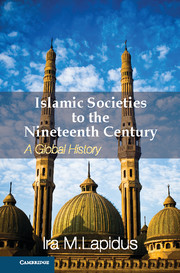Book contents
- Frontmatter
- Contents
- List of Illustrations
- List of Figures
- List of Maps
- List of Tables
- Preface
- Acknowledgments
- Acknowledgments to the first edition of A History of Islamic Societies
- Acknowledgments to the second edition of A History of Islamic Societies
- Publisher's Preface
- Introduction to Islamic Societies
- Part I The Beginnings of Islamic Civilizations
- Part II From Islamic Community to Islamic Society
- Part III The Global Expansion of Islam from the Seventh to the Nineteenth Centuries
- Chapter 25 Introduction: Islamic Institutions
- The Western Islamic Societies
- Islam in Asia
- Islam in Africa
- Conclusion
- Glossary
- Bibliography
- Annotated Bibliography from A History of Islamic Societies, 2nd Edition
- Index
Chapter 25 - Introduction: Islamic Institutions
Published online by Cambridge University Press: 05 February 2013
- Frontmatter
- Contents
- List of Illustrations
- List of Figures
- List of Maps
- List of Tables
- Preface
- Acknowledgments
- Acknowledgments to the first edition of A History of Islamic Societies
- Acknowledgments to the second edition of A History of Islamic Societies
- Publisher's Preface
- Introduction to Islamic Societies
- Part I The Beginnings of Islamic Civilizations
- Part II From Islamic Community to Islamic Society
- Part III The Global Expansion of Islam from the Seventh to the Nineteenth Centuries
- Chapter 25 Introduction: Islamic Institutions
- The Western Islamic Societies
- Islam in Asia
- Islam in Africa
- Conclusion
- Glossary
- Bibliography
- Annotated Bibliography from A History of Islamic Societies, 2nd Edition
- Index
Summary
Between the seventh and the thirteenth centuries, the historical institutions of pre-Islamic Middle Eastern societies were recast in Islamic forms. New empires and states were organized under Islamic practices of authority and symbols of legitimacy. Muslim religious elites, including scholars (ʿulamaʾ) and Sufi holy men, generated Islamic forms of worship, education, and legal administration. The majority of Middle Eastern peoples became Muslim, although what that meant in practice varied by region; pastoral tribes, peasants, urban artisans, merchants, and state elites elaborated diverse Islamic identities. A new civilization, in part royal and artistic, in part urban and pietistic, came into being.
In subsequent eras, an Islamic system of institutions and its various cultures would continue to evolve in the already Islamized regions of the Middle East – including Iran, Transoxania, and the Arab provinces. These societies would also serve as a paradigm for the establishment of Islamic societies in other parts of the world. From the seventh to the nineteenth centuries, Islamic societies – based on the interaction of local institutions and cultures and Middle Eastern influences – were established in Anatolia and the Balkans, Inner Asia, South and Southeast Asia, and sub-Saharan Africa. The development of a global system of Islamic societies, however, was blocked in the eighteenth and nineteenth centuries by the growing political and economic power of Europe. The consolidation of European colonial rule in most of the Muslim world marks the end of the pre-modern era and the beginning of the modern transformation of Muslim societies. (See Map 9.)
- Type
- Chapter
- Information
- Islamic Societies to the Nineteenth CenturyA Global History, pp. 343 - 368Publisher: Cambridge University PressPrint publication year: 2012



